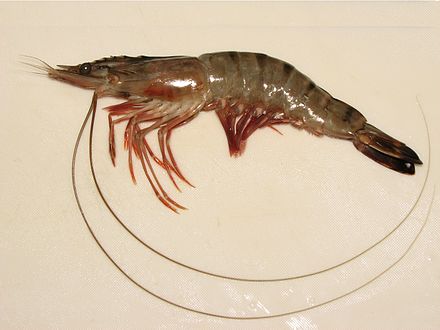Caridea
The Caridea, commonly known as caridean shrimp or true shrimp, are an infraorder of shrimp within the order Decapoda. This infraorder contains all species of true shrimp. They are found widely around the world in both fresh and salt water. Many other animals with similar names – such as the mud shrimp of Axiidea and the boxer shrimp of Stenopodidea – are not true shrimp, but many have evolved features similar to true shrimp.
Carideans are found in every kind of aquatic habitat, with the majority of species being marine. Around a quarter of the described species are found in fresh water, however, including almost all the members of the species-rich family Atyidae and the Palaemonidae subfamily Palaemoninae.[1] They include several commercially important species, such as Macrobrachium rosenbergii, and are found on every continent except Antarctica.[1] The marine species are found at depths to 5,000 m (16,000 ft),[2] and from the tropics to the polar regions.
In addition to the great variety in habitat, carideans vary greatly in form, from species a few millimetres long when fully grown,[3] to those that grow to over a foot long.[2] Except where secondarily lost, shrimp have one pair of stalked eyes, although they are sometimes covered by the carapace, which protects the cephalothorax.[2] The carapace also surrounds the gills, through which water is pumped by the action of the mouthparts.[2]
Most carideans are omnivorous, but some are specialised for particular modes of feeding. Some are filter feeders, using their setose (bristly) legs as a sieve; some scrape algae from rocks. The snapping shrimp of the genus Alpheus snap their claws to create a shock wave that stuns prey. Many cleaner shrimp, which groom reef fish and feed on their parasites and necrotic tissue, are carideans.[2] In turn, carideans are eaten by various animals, particularly fish and seabirds, and frequently host bopyrid parasites.[2]
Unlike Dendrobranchiates, Carideans brood their eggs rather than releasing them into the water. Caridean larvae undergo all naupliar development within the egg, and eclose as a zoea. The zoea stage feeds on phytoplankton. There can be as few as two zoea stages, (e.g. some freshwater Palaemonidae), or as many as 13, (e.g. some Pandalidae). The post-zoeal larva, often called a decapodid, resembles a miniature adult, but retains some larval characteristics. The decapodid larva will metamorphose a final time into a post-larval juvenile: a young shrimp having all the characteristics of adults.[4] Most adult carideans are benthicanimals living primarily on the sea floor.
Common species include Pandalus borealis (the "pink shrimp"), Crangon crangon (the "brown shrimp") and the snapping shrimp of the genus Alpheus. Depending on the species and location, they grow from about 1.2 to 30 cm (0.47 to 11.81 in) long, and live between 1.0 and 6.5 years.[5]

